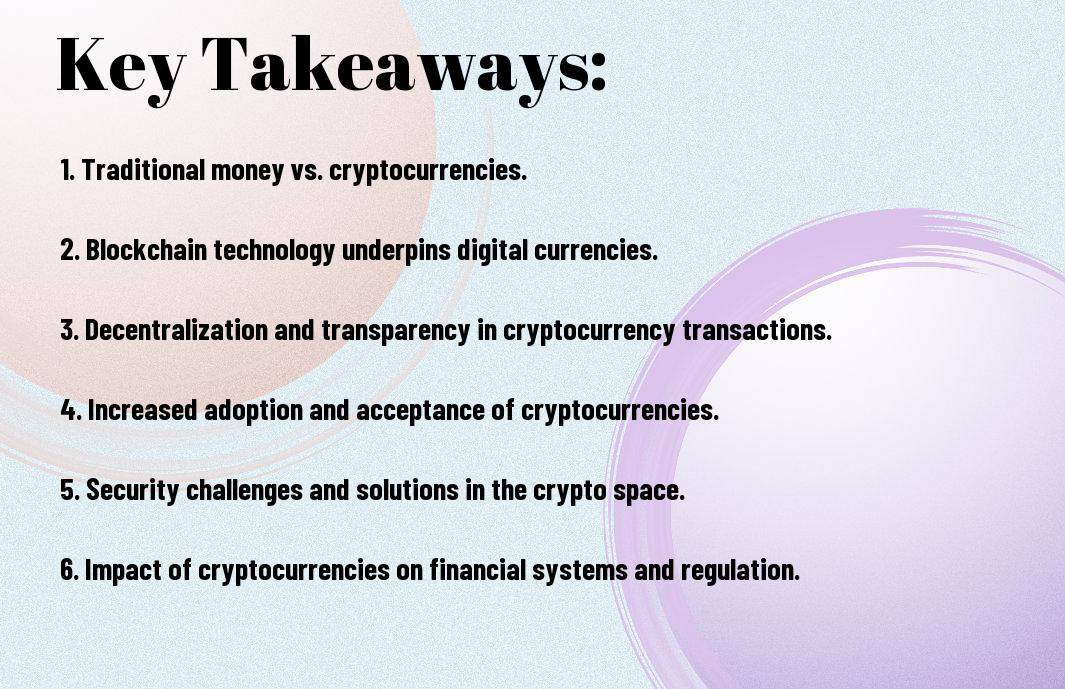With the rise of cryptocurrencies such as Bitcoin, Ethereum, and Litecoin, there has been a significant shift in the way we perceive and use money. Understanding this transition from traditional fiat currencies to digital assets is crucial in navigating the evolving financial landscape. Cryptocurrencies offer a decentralized, secure, and borderless alternative to traditional banking systems, revolutionizing the way we store and exchange value.

Key Takeaways:
- Cryptocurrencies are digital assets: Transitioning from fiat to digital currencies involves a shift from physical to digital forms of money.
- Decentralization is a key feature: Cryptocurrencies operate on a decentralized network, eliminating the need for intermediaries like banks or governments.
- Blockchain technology ensures security: The use of blockchain in cryptocurrencies ensures transparency, immutability, and security in transactions.
- Volatility is a common characteristic: Cryptocurrencies are known for their price fluctuations, making them a high-risk investment option.
- Global acceptance is on the rise: More businesses and individuals are starting to accept cryptocurrencies as a form of payment, expanding their utility.
- Regulatory challenges persist: Governments are grappling with how to regulate cryptocurrencies, leading to a complex legal landscape in the industry.
- Educating yourself is key: Before entering into the world of cryptocurrencies, it is crucial to understand the technology, risks, and benefits involved in using digital currencies.


The Fundamentals of Fiat Currency
Little is understood about the very foundation of our modern economic life – fiat currency. Fiat money is the currency that a government has declared to be legal tender, but it is not backed by a physical commodity like gold or silver. Instead, its value is derived from the trust and faith of the people who use it.
Definition and Characteristics of Fiat Money
One of the key characteristics of fiat money is that it is not redeemable for any commodity, meaning there is no intrinsic value attached to the currency itself. Its value comes from the belief that it can be exchanged for goods and services. Additionally, governments have the power to control the supply of fiat money, allowing them to implement monetary policies to manage inflation and interest rates.
Historical Development and Role of Fiat Currencies
Role in shaping the modern economy has been immense as fiat currencies replaced commodity money like gold and silver, bringing more flexibility and stability to financial systems. The shift towards fiat money began in the 20th century, with governments transitioning from the gold standard to fiat currencies to have more control over monetary policy and support economic growth.
To summarize, fiat currencies play a crucial role in the functioning of modern economies, providing governments with the flexibility to regulate economic activity. However, the reliance on trust and government stability for the value of fiat money can pose risks such as inflation or currency devaluation. Proper understanding of these aspects is vital for comprehending the transition to digital currencies.
Understanding Cryptocurrencies
To From Fiat to Crypto: The Present and Future of Money, cryptos have emerged as a revolutionary form of digital currency in recent years. These digital assets operate independently of traditional banking systems and have gained significant popularity due to their decentralized and secure nature.
What Are Cryptocurrencies?
What exactly are cryptocurrencies? In essence, they are digital or virtual currencies that use cryptography for security. What sets them apart from traditional currencies is the fact that they are decentralized and typically operate on a technology called blockchain. This technology ensures the integrity and security of transactions without the need for a central authority to oversee them.
The Technology Behind Cryptocurrencies: Blockchain
For those delving into the world of cryptocurrencies, understanding blockchain is crucial. This technology serves as the backbone of most cryptocurrencies and is a decentralized digital ledger that records transactions across a network of computers. Blockchain offers transparency, security, and immutability, making it a powerful tool for ensuring the integrity of transactions. For instance, once a transaction is recorded on a block, it cannot be altered, providing a high level of security against fraud and tampering.
The Transition Phenomenon
Unlike traditional fiat currencies, cryptocurrencies represent a digital form of money that operates independently of a central authority. This decentralized nature has sparked a transition phenomenon where individuals and businesses are increasingly adopting cryptocurrencies for various transactions and investments.
Early Adoption of Cryptocurrencies
To understand the transition to cryptocurrencies, we must first look at the early adopters who recognized the potential of digital assets. These pioneers were tech-savvy individuals who saw the benefits of using cryptocurrencies for fast, secure, and borderless transactions. They understood the disruptive potential of blockchain technology and were willing to take the risk to be part of a financial revolution.
Factors Leading to the Shift from Fiat to Digital
Leading to the shift from fiat to digital are several key factors that have influenced the widespread adoption of cryptocurrencies. The transparency and security offered by blockchain technology have instilled trust among users, while the low transaction fees and quick settlement times have made cryptocurrencies an attractive alternative to traditional banking systems.
- Digital transactions
- Blockchain technology
- Trust and security
Perceiving the potential for growth and innovation, more individuals and businesses are embracing cryptocurrencies as a way to diversify their portfolios and participate in a rapidly evolving financial landscape.
Cryptocurrencies
Cryptocurrencies offer a decentralized system that is resistant to censorship, fraud, and government interference. While this autonomy provides users with greater financial freedom, it also exposes them to risks such as market volatility and potential security breaches. However, the positive aspects of cryptocurrencies such as instant transactions, international accessibility, and financial inclusivity continue to drive the transition away from traditional fiat currencies.
Cryptocurrencies vs. Fiat Currencies
Advantages of Cryptocurrencies Over Traditional Money
Your search for the future of financial transactions has led you into cryptocurrencies. As you investigate into this world, it’s vital to understand the advantages that these digital currencies offer over traditional fiat money. One of the key advantages of cryptocurrencies is decentralization, meaning they are not controlled by any government or financial institution. This provides a level of autonomy and independence that is not present with fiat currencies. Transactions with cryptocurrencies are also typically faster and cheaper compared to traditional money transfers, especially when dealing with cross-border transactions.
Challenges and Limitations of Digital Currencies
Fiat currencies have long been the standard form of money, but the rise of digital currencies presents its own set of challenges and limitations. An inherent challenge with cryptocurrencies is their volatility, with prices capable of fluctuating dramatically in short periods. Regulatory concerns and security risks also loom over the digital currency market, as the lack of a central authority can make it challenging to address issues such as fraud and money laundering.
Additionally, one of the biggest limitations of digital currencies is their acceptance level in mainstream markets and businesses. While the popularity of cryptocurrencies is growing, many establishments still do not accept them as a form of payment. Overcoming these challenges will be crucial for the widespread adoption and integration of digital currencies into our daily lives.
The Impact on Banking and Financial Systems
Once again, the rise of cryptocurrencies is reshaping the landscape of traditional banking and financial systems. The decentralized nature of cryptocurrencies challenges the centralized control of traditional banking institutions, leading to significant changes in how individuals and businesses interact with money.
Disruption in Traditional Banking
Banking institutions are facing disruption as more individuals turn to cryptocurrencies for their financial transactions. Traditional banks are no longer the sole gatekeepers of financial services, as cryptocurrencies provide alternatives for payments, investments, and lending without the need for intermediaries. This shift is forcing banks to reevaluate their business models and adapt to the changing financial ecosystem to stay competitive.
Emergence of Decentralized Finance (DeFi)
Disruption in the financial sector has paved the way for the emergence of Decentralized Finance (DeFi). DeFi leverages blockchain technology to create a decentralized financial system that allows individuals to access financial services such as borrowing, lending, and trading without relying on traditional intermediaries like banks. This newfound financial freedom empowers individuals to have more control over their assets and investments.
Decentralized Finance (DeFi) has the potential to revolutionize traditional financial systems by increasing accessibility, transparency, and efficiency in financial transactions. However, it also poses challenges such as regulatory concerns and security risks that need to be addressed for widespread adoption. As the DeFi space continues to grow, it is crucial for traditional banking institutions to adapt to this new era of finance to stay relevant in the evolving financial landscape.
Regulatory Responses to Cryptocurrencies
After gaining popularity, cryptocurrencies have caught the attention of regulatory bodies worldwide. The decentralized and often pseudo-anonymous nature of digital currencies has led to concerns about their potential misuse in illegal activities, such as money laundering and tax evasion. To explore deeper into this topic, explore the article on Understanding Digital Currency and Its Far-Reaching Impacts.
Global Regulatory Landscape
One significant challenge in regulating cryptocurrencies is the lack of a consistent approach across different jurisdictions. While some countries have embraced cryptocurrencies and established clear regulatory frameworks, others have taken a more cautious or prohibitive stance. This disparity poses challenges for businesses operating in the digital currency space, as they must navigate a complex web of regulations to ensure compliance.
The Effect of Regulation on Cryptocurrency Adoption
Regulatory responses play a crucial role in shaping the adoption and acceptance of cryptocurrencies within mainstream financial systems. For instance, strict regulations can create barriers to entry for new users and businesses looking to utilize digital currencies. On the other hand, clear and supportive regulations can enhance trust and legitimacy, ultimately driving wider adoption of cryptocurrencies.

The Future of Currencies
Many experts and economists believe that the future of currencies is becoming increasingly digital. As more people and businesses adopt and embrace cryptocurrencies, the landscape of traditional fiat currencies is expected to undergo a significant transformation. The rise of decentralized finance, or DeFi, platforms and the integration of blockchain technology into various sectors are likely to shape the future of money.
Predictions for the Evolution of Money
With the advent of cryptocurrencies like Bitcoin, Ethereum, and a myriad of altcoins, the traditional concept of money is evolving rapidly. Experts predict that in the coming years, digital currencies will play a more prominent role in everyday transactions and investments. The increasing digitization of money may lead to faster and cheaper cross-border transactions, reduced dependency on centralized financial institutions, and greater financial inclusion for individuals worldwide. However, challenges such as regulatory hurdles, security concerns, and market volatility will need to be addressed for this evolution to be smooth and successful.
Preparing for a World Where Digital Currency Is King
King As digital currencies continue to gain mainstream acceptance, individuals and businesses must adapt to this new financial landscape. Educating oneself about the intricacies of cryptocurrencies, understanding the underlying blockchain technology, and learning how to securely store and manage digital assets will be crucial. Additionally, being aware of the risks and rewards associated with digital currencies is necessary for navigating the evolving financial ecosystem successfully.
To wrap up
Presently, the shift towards cryptocurrencies represents a fundamental change in the way we understand and interact with money. While fiat currencies have been the dominant form of money for centuries, the rise of digital currencies has opened up a new realm of possibilities. By understanding the differences between fiat and digital currencies, individuals and businesses can better navigate this evolving landscape and make informed decisions about how they manage and use their money.
As the adoption of cryptocurrencies continues to grow, it is vital for individuals to educate themselves on the benefits and risks associated with these digital assets. By staying informed and adapting to this new financial paradigm, we can embrace the potential that cryptocurrencies offer for greater financial freedom and innovation. From fiat to digital, the shift towards cryptocurrencies is a transformative trend that is reshaping the future of money.
FAQ
Q: What is the shift from Fiat to Digital currencies?
A: The shift from Fiat to Digital currencies refers to the movement towards using digital assets such as cryptocurrencies as a medium of exchange, rather than traditional Fiat currencies issued by governments.
Q: Why are people making the shift to Digital currencies?
A: People are attracted to Digital currencies due to their decentralized nature, lower transaction fees, faster transaction times, security features, and potential for investment returns.
Q: How do cryptocurrencies differ from Fiat currencies?
A: Cryptocurrencies differ from Fiat currencies as they are digital or virtual currencies that use cryptography for security and operate on decentralized networks based on blockchain technology, whereas Fiat currencies are physical currencies issued by governments and regulated by central banks.
Q: What are the risks associated with using cryptocurrencies?
A: Risks associated with using cryptocurrencies include price volatility, security vulnerabilities, lack of regulatory oversight, potential for hacking and fraud, and the risk of losing access to your digital wallet.
Q: How can someone start using cryptocurrencies?
A: To start using cryptocurrencies, one must first choose a secure digital wallet, select a reputable cryptocurrency exchange to buy digital assets, store private keys securely, and practice caution when making transactions to avoid scams.
Q: What is the future outlook for the adoption of cryptocurrencies?
A: The future outlook for the adoption of cryptocurrencies is positive, with increasing acceptance by businesses, financial institutions, and governments worldwide, leading to greater mainstream usage and integration into various sectors of the economy.
Q: How can individuals educate themselves about cryptocurrencies?
A: Individuals can educate themselves about cryptocurrencies by reading reputable sources, attending seminars and webinars, participating in online forums, joining cryptocurrency communities, and staying informed about market trends and regulatory developments.



